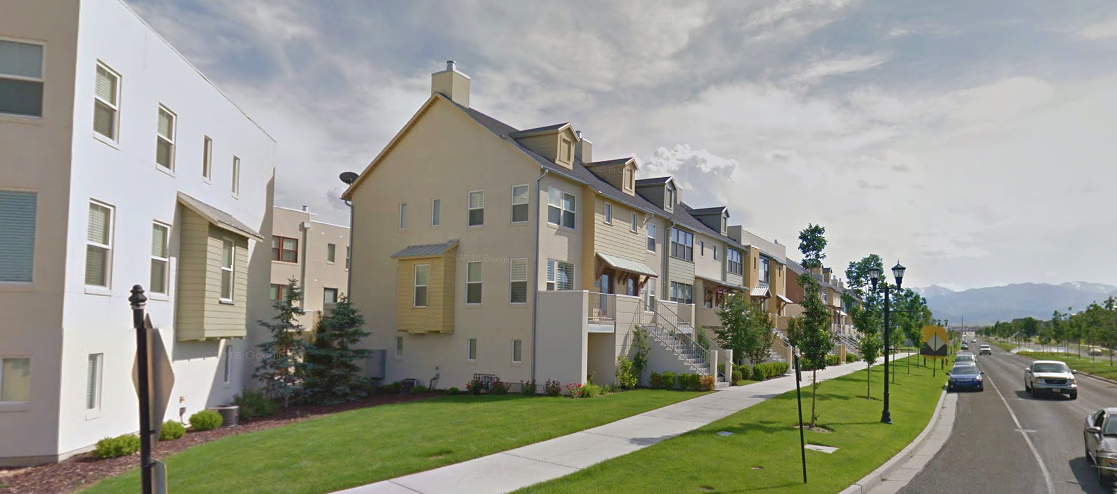On January 31, 2019, CNU Utah invited four people to present at one of the Chapter’s UrbanTHINK events on the topic, “The Future of New Urbanism.” Each person took a very different approach to the topic. Over several weeks, we are posting about their remarks in hopes of inspiring further thought and discussion of where New Urbanism is headed. This fourth and final installment in the series reports on the presentation by Jeff Farnum, Manager of Architecture and Design at Daybreak. Prior to coming to Daybreak, Jeff worked as an architect at 4cdesign group in Park City and at FFKR Architects in Salt Lake.

Jeff began his remarks by explaining that as manager of architecture and design at Daybreak, he is mostly familiar with and works at the neighborhood & street level – particularly with how things have played out at Daybreak. As he prepared for this presentation, he reviewed once again the Charter of the New Urbanism & noted that we are still trying to achieve the ideals stated in it. Daybreak, as a master-planned community initially owned by a mining company, negotiated a development agreement with the City of South Jordan to implement its own zoning & design guidelines. Thus, at Daybreak the developer to a great extent plays the role of regulator to the builders it allows into the community as it strives to implement the Charter in the community.
Jeff noted that Daybreak is not quite halfway through its 20,000 entitled dwelling units, which range from town homes up to 5,000 sq. ft. single-family homes. Even this far into development and having proven itself to be quite successful in the market, Daybreak still encounters frequent resistance from builders, citing market constraints on what & how they can build.

Jeff went on to observe that as you move a new community forward in trying to achieve the Charter, there are several really critical things to consider. One of these: filling the gap which exists in the range of housing needs. Daybreak has done a pretty good job in addressing the Missing Middle. Builders are always looking for the sweet spot in terms of what is going to sell, while the developer of Daybreak is constantly trying to reconcile this need with its own design and community goals. Through all of this, builders still sometimes insist that market forces prevent them from doing what Daybreak is looking for – particularly as it relates to achieving a walkable community. One of Daybreak’s self-imposed measures of its own success is in the reduction in the number of car-miles traveled. Once you are in your car, you are pretty much going to drive to where you need to go to get your needs met. If you can’t meet needs within walking distance, you get in the car; hence, the importance of reducing the frequency of needing to get in a car in the first place.

One of Jeff’s frustrations has been that, even as Daybreak has tried to develop according to New Urban principles, the area surrounding the community has continued to grow at a much greater rate according to conventional suburban forms. Commercial implementation in Daybreak in particular has been a huge problem, as conventional big-box and strip centers full of large chains have grown up on Daybreak’s perimeter. He noted that these commercial developers understand their business model very well, and they are not interested in experimenting with a different business model. That begs the question: how do you implement Daybreak’s walkable goals into the greater surrounding community? For Daybreak to work as a walkable place, it needs to continue to grow with more mixed-use and live-work development. But would-be developers and builders in Daybreak look at the financially successful but very conventional development surrounding the community and are unwilling to take the risks of competing against it with these still-new forms. And it follows that without the full range of land uses and development forms needed for a truly walkable community, you wind up with just another form of suburban sprawl.
Jeff went on to note that Daybreak has been successful in increasing the market desirability of its residential forms, which in turn has been a factor in housing prices going up. But as its homes have become less affordable, Daybreak has become a victim of its own success. Town homes there now cost more than single-family homes did ten years ago – a problem. So what do you do? Part of Daybreak’s solution to this has been to focus on even more economical housing strategies via different forms of higher-density housing.

NIMBYism also has become a constant struggle at Daybreak, even among its own residents who one would think have caught the vision of what Daybreak is all about. Jeff suggests that NIMBYism, particularly against multifamily housing, could be better mitigated, at Daybreak and elsewhere, if we were to develop in ways which were more responsible & more appealing – if the design were better. That notwithstanding, some people will object to virtually anything you try to build next to them.
Jeff ended with the observation that critics of New Urbanism often object to what they perceive as an NU focus on traditional building styles. But, Jeff asserted, New Urbanism really transcends architectural styling. Consequently, Daybreak has tried to avoid adopting uniform styling details across the development. It may be easier to talk traditional-style language with builders when you are trying to get them to do something; and building modernism is more expensive. But, Jeff asserted, various styles all have a place. CNU needs to work toward a goal of being “style-agnostic,” because there is both good and bad architecture which is both modern and traditional.

